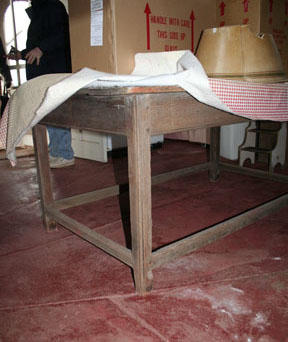
However, even with the carpenters' bill and the physical evidence discovered on the wall, architectural historian Mark Wenger did not have enough information to design the new dresser. Major unresolved issues included how the table legs were constructed, how the shelves were supported, what type of wood to use, how to finish the edges of the boards, and what kind of knobs to use for the drawers. In these situations where no similar examples could be found at Montpelier, the Restoration Team turned to surviving examples from the same period found at other sites. In this case the design was largely based off of two period examples. The first example was a kitchen table found at a ca. 1816 Virginia plantation house that was also built by John Neilson and it provided evidence for how the base of the dresser was constructed. The second example was found at Mount Airy Plantation in Richmond County, Virginia and it was used to detail the dresser's shelves.

©The Montpelier Foundation
|
|
A surviving ca. 1816 kitchen table that was built by John Neilson for a kitchen at Bremo in Fluvanna County, VA. |







